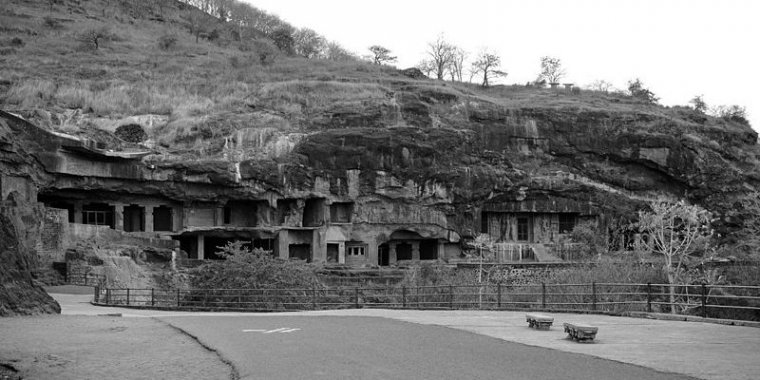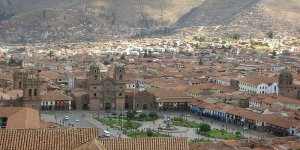| Published in Destinations |
Ellora, India

Ellora Buddhist Caves, Aurangabad, India. ![]()
Ellora Caves are an impressive complex of rock shrines that represent the three faiths of Buddhism, Hinduism and Jainism and were created between the 5th and the 13th centuries CE. The caves, a UNESCO World Heritage Site, are 30 km northwest of central Aurangabad, a few km from Khuldabad, and 330 km northeast of Mumbai in Maharashtra state.
The Ellora caves are about 100 kilometres (62 miles) west from the Ajanta Caves.
Get in
• By plane. Aurangabad has the nearest airport (36 km), and there are daily flights from Delhi and Mumbai.
• By train. Aurangabad is the nearest railway station, and there are regular trains from Mumbai, Hyderabad, Delhi, Amritsar etc. There is an overnight train from Mumbai.
• By bus. MSRTC (Maharashtra State Road Transport Corporation) Red Buses are available at regular intervals to Ellora. The frequency is good, and they are extremely safe and fairly comfortable, though not very luxurious. MSRTC also operates semi-luxury Asiad buses to here but the frequency is not very good. All these buses depart from and arrive at the Aurangabad Central Bus Stand (CBS). There is no need for advance booking and tickets are issued on the bus itself.
Tourists who wish to travel to Ellora are STRONGLY RECOMMENDED to travel only in MSRTC (Maharashtra State Road Transport Corporation) buses from Aurangabad CBS (Central Bus Stand). Maxi-cabs (medium sized black-yellow taxis) parked outside the Aurangabad CBS (Central Bus Stand) are extremely unsafe.
• By taxi. One can reserve a chauffeur-driven taxi / tourist taxi from Aurangabad which will charge around INR350-INR400.
Get around
There are numerous bus services running to Ellora from Aurangabad Central Bus Station, but the Maharashtra State Tourism Corporation (MTDC) Bus Service is most reliable. There is a luxury bus tour departing daily at 8AM from the MTDC office on Railway Station Road. In addition to Ellora, the tour also includes several famous sites in Aurangabad.
Taxis of all types are available from Aurangabad. Daulatabad Fort is on the way to Ellora.
What to See in Ellora
The 34 caves at Ellora and the 29 caves at Ajanta remained in obscurity for over a millennium, till John Smith, a British Army Officer, accidentally stumbled upon them while on a hunting expedition in 1819. Ajanta and Ellora are protected monument sites under the Archaeological Survey of India and has been included in the World Heritage list of monuments.
• Ellora Caves. 9.00AM to 17.30PM closed on Tuesday, Open on ALL National Holidays. The entry fees INR30 for Indians, INR500 for Foreigners. Free entry for children below 15 years. Still Photography: Free, Video Photography: INR25.
— Kailasanatha temple (Cave #16).
— Cave 1 (The southernmost cave). Houses some of the best-preserved wall paintings here, which include two impressive Bodhisattvas, Padmapani and Avalokiteshvara.
— Cave 6, 10, 11, 12, 14, 15, 16, 21, 29, 30, 30A, 31, 32, 33, 34. Must to see. Inscriptions were found at Cave 15, 21, 31
— Chota Kailash (Cave 30) (Next to Jain Group).
— Dhumar Lena (Cave 29), early Hindu temple.
— Dashawatara (Cave 15).
— Jain Group of Ellora Caves (Cave 31-34) (North of Dhumar Lena).
— Waterfall (Next to Dhumar Lena).
These murals and frescoes adorning the walls of these structures depict the story of Buddhism, spanning the period from 200 BC to 650 AD. Many of the caves have panels depicting stories from the Jatakas, a treasure trove of stories about the several incarnations of the Buddha. This makes the Ajanta caves a fascinating spiritual tourist attraction for Buddhists and scholars and researchers of Buddhism.
Caves 2, 16, and 17 also contain amazing paintings, while caves 1, 4, 17, 19, 24, and 26 boast of some of the most divine sculptures. The flying apsara painting in Cave 17, and the image of the Buddha preaching, also in cave 17, are two unforgettable works of art in Ajanta. The Ajanta caves and the treasures they house are a landmark in the overall development of Buddhism in India and in general.
The nobility, grace and serenity inherent in Buddha is reflected in the sculptures of these caves. Caves 6 and 10 house images from the Buddhist and Hindu faith, under the same roof, the latter dedicated to Vishwakarma, the patron saint of Indian craftsmen. The Vishvakarma cave is both a Chaitya and a Vihara, with a seated Buddha placed in the stupa. Its two-storeyed structure sports a colourful pageant of dwarfs, dancing and making music.
The Kailasa temple in Cave 16 is architecture. The entire structure was an exquisite piece carved out of a monolith, the process taking over a century to finish. This mountain-abode of Lord Shiva, is in all probability, the world's largest monolith, the gateway, pavilion, assembly hall, sanctum and tower, all hewn out of a single rock.
The most striking feature about this structure is that unlike other temple structures that are built base onwards, the sculptures or architects of this majestic and fantastic sculptures started carving from the very top and the sides. The gigantic yet delicate and intricate piece of ancient work is the most amazing structure here.
The Dumar Lena cave, dedicated to Lord Shiva, resembles the famous cave temple of Elephanta. The Jain caves are about a mile away from the Kailasa temple, amongst which Cave 32, houses a beautiful shrine adorned with fine carvings of a lotus flower on the roof, and a yakshi on a lion under a mango tree, while Caves 32 and 34 contain grand statues of Parasnath.
The other Jain caves sport the images of Tirthankaras, and one of them, also, has a seated figure of Mahavira. These caves are a treasure of India which hold the wealth and display the rich Indian heritage.
• Ghrishneshwar temple, Grishneswar temple Rd, Verul (half a kilometer from the Ellora Caves). It is an 18th-century temple that presents outstanding architecture and carving. This place forms one of the five Jyotirlinga sites in Maharashtra where Lord Shiva is worshipped. The Holkar temple nearby is a must-see.
What to Do in Ellora
Every year in the third week of March, M T D C organizes the Ellora Festival of Classical Dance and Music at the caves.
Buy
Buy Archaeological Survey of India Book - World Heritage Series "ELLORA" ( INR99 )
Eat
Hotel Kailash is an older hotel and has an attached Beer Bar. Hotel Manor, Hotel Ambience and several other Indian restaurants are along the road to Aurangabad from Ellora. Hygiene and spice level may be an issue for some.
Sleep
• Hotel Kailash. The closest hotel to Ellora Caves – a few meters from the entrance. The hotel offers cottages and standard rooms. A few of the cottages overlook the caves but are priced slightly higher than the normal cottages.
• Alternatively, one can stay at Aurangabad and visit the caves on a day trip.
Go next
• Aurangabad (toward southeast)
• Indore (toward north) (Wikivoyage)
See also Ellora in Pictures
YOU MAY ALSO LIKE





 If you own or manage a travel-related business such as a hotel, a bed-and-breakfast, a restaurant, a pub or a cafeteria, you can create a web page for your business for free on Titi Tudorancea Travel Info. » |
